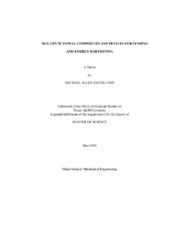| dc.description.abstract | This research investigates a novel class of active materials for energy and sensing applications. Magnetocaloric alloys, Gd5Si2Ge2, were developed into a composite with poly(vinylidine flouride) (PVDF), piezoelectric polymer. The giant megnetocaloric property combined with the piezoelectricity creates extraordinary properties for composite materials.
The research approach was primarily experimental. Activities include synthesis, characterization, and device design and evaluation. Using the arc melting method, the magenetocaloric samples were created. Multi-length scales characterized using atomic force microscopy (AFM), optical microscopy, scanning electron microscopy (SEM) with energy dispersive spectroscopy (EDS), X-Ray diffraction (XRD), and X-Ray Photoelectron spectroscopy (XPS). The prototype devices were evaluated for their power generation and efficiency. Through those techniques, the fundamental understanding in the new materials was obtained. The relationships between process-microstructures, microstructure-properties, and structure-power generation were established.
Results showed that the phase transformation of the magnetocaloric material at its Curie temperature induced a significant increase in power generation in the peizeoelectric polymer. Such transition was also beneficial for a laminated device for energy harvesting. In addition, it was found that the oxidation that occurred during high temperature melting stabilized the orthorhombic phase at room temperature. The multifunctional composites as well as the laminated structure use the thermal expansion of the magnetocaloric material for energy harvesting, cyclic monitoring, and/or thermal switching.
This thesis consists of six chapters. Chapter I provides a history and explanation of the materials used. Chapter II provides an explanation of the motivation for this work. Chapter III addresses the experimental procedures. The results of which are presented in Chapter IV and discussed in Chapter V. The research is summarized and future recommendations are given in Chapter VI. | en |


